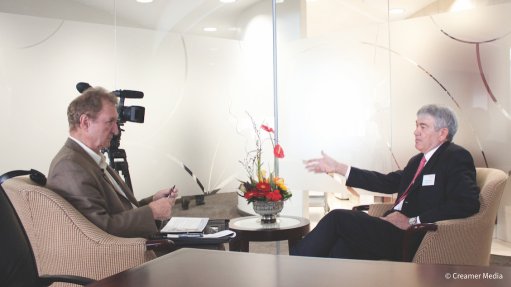Proposed underground lab in South Africa moves into project stage
A proposal to build South Africa’s and Africa’s first underground science laboratory has now moved into the project stage, with the launch of the Paarl Africa Underground Laboratory (PAUL), following a recent science symposium on the concept. Although South African scientists have set up temporary underground labs before, this will be the first permanent such facility in the country and continent, and only the second in the southern hemisphere (the first being in Australia).
(The symposium was sponsored by the Department of Science and Innovation [DSI] and supported by Stellenbosch University and the University of the Western Cape, as well as by France’s National Institute of Nuclear and Particle Physics and Italy’s National Institute for Nuclear Physics.)
The DSI has provided seed funding to get the project off the ground. The concept is that PAUL would have a volume of some 10 000 m3, and be located some 800 m underground, beneath the Du Toits Kloof mountains, near Paarl, in the Western Cape province.
Investigations into the creation of a permanent underground lab in the country started in 2011. Originally, the focus was on South Africa’s very deep level gold mines. It had been in a temporary lab, set up in one of these mines, some 3 000 m below the surface of the East Rand (that part of the Witwatersrand east of Johannesburg), that, back in 1965, South African physicist Friedel Sellschop and American physicist (and 1995 Nobel Physics Prize winner) Frederick Reines made the first ever observation of a naturally occurring neutrino (an elementary particle).
Recently, however, the investigation changed its focus to the Western Cape and specifically to the Huguenot tunnel. This is a 4 km road tunnel under the Du Toits Kloof mountains, linking the towns of Paarl and Worcester. It is the longest such tunnel in South Africa, and managed by the South African National Roads Agency Limited (Sanral).
The opportunity has been created by Sanral’s plan to upgrade the North Bore tunnel, hitherto used as a service tunnel, to become a traffic tunnel, to relieve the pressure on the current sole traffic tunnel, known as the South Bore tunnel. An engineering feasibility study will be done on the viability of including the creation of the underground laboratory, as part of Sanral’s upgrade programme.
Underground labs were created to detect rare particles, by using the thick rock layers above them to screen out unwanted background phenomena, such as cosmic ray showers. Only by screening out this “noise” can these rare or difficult-to-detect particles be observed. Already in 2015, the scientific suitability of the Huguenot tunnel site, for an underground lab, was established by a study by Stellenbosch University and iThemba LABS (Laboratories for Accelerator Based Sciences) radiation research groups.
Once operational, PAUL would complement the radio telescope arrays already existing or being created in South Africa – MeerKAT, HERA (the Hydrogen Epoch of Reionisation Array), and the Square Kilometre Array – especially regarding the investigation of dark matter, believed to make up 85% of the matter of the universe. PAUL would also strengthen the global underground lab network, currently composed of only a dozen such facilities.
Additionally, more recently, underground labs have greatly expanded the areas, indeed the disciplines, of science that they undertake studies in. And research is currently under way into how PAUL could also benefit scientists in the disciplines of biology, chemistry and the geosciences, as well as researchers in the fields of mining technology and underground architecture and construction. It would also benefit the local communities, through job creation and skills development.
All being well, PAUL could become operational in five to ten years from now.
Article Enquiry
Email Article
Save Article
Feedback
To advertise email advertising@creamermedia.co.za or click here
Comments
Press Office
Announcements
What's On
Subscribe to improve your user experience...
Option 1 (equivalent of R125 a month):
Receive a weekly copy of Creamer Media's Engineering News & Mining Weekly magazine
(print copy for those in South Africa and e-magazine for those outside of South Africa)
Receive daily email newsletters
Access to full search results
Access archive of magazine back copies
Access to Projects in Progress
Access to ONE Research Report of your choice in PDF format
Option 2 (equivalent of R375 a month):
All benefits from Option 1
PLUS
Access to Creamer Media's Research Channel Africa for ALL Research Reports, in PDF format, on various industrial and mining sectors
including Electricity; Water; Energy Transition; Hydrogen; Roads, Rail and Ports; Coal; Gold; Platinum; Battery Metals; etc.
Already a subscriber?
Forgotten your password?
Receive weekly copy of Creamer Media's Engineering News & Mining Weekly magazine (print copy for those in South Africa and e-magazine for those outside of South Africa)
➕
Recieve daily email newsletters
➕
Access to full search results
➕
Access archive of magazine back copies
➕
Access to Projects in Progress
➕
Access to ONE Research Report of your choice in PDF format
RESEARCH CHANNEL AFRICA
R4500 (equivalent of R375 a month)
SUBSCRIBEAll benefits from Option 1
➕
Access to Creamer Media's Research Channel Africa for ALL Research Reports on various industrial and mining sectors, in PDF format, including on:
Electricity
➕
Water
➕
Energy Transition
➕
Hydrogen
➕
Roads, Rail and Ports
➕
Coal
➕
Gold
➕
Platinum
➕
Battery Metals
➕
etc.
Receive all benefits from Option 1 or Option 2 delivered to numerous people at your company
➕
Multiple User names and Passwords for simultaneous log-ins
➕
Intranet integration access to all in your organisation
















